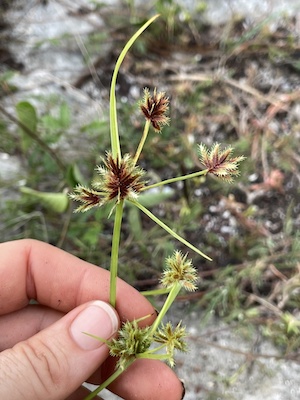Plants of South Florida · Plants by Conservation Area · Plants by County · Plants by Habitat Quick Search · Advanced Search |
||
|
|
||
 |
Cyperus squarrosus L. Bearded flatsedge |
|
|
South Florida Status: Critically imperiled. Two occurrences in one conservation area (National Key Deer Refuge) and one non-conservation area (Valhalla Rock Barren Site). Taxonomy: Monocotyledon; Cyperaceae. Habit: Annual terrestrial herb. Distribution: Native to the United States, Mexico, Central America, South America, the West Indies, and the Old World. Wunderlin (1998) reports it as occasional in Florida in South Florida, and in Hillsborough County, Escambia County, and the central panhandle. South Florida Distribution: Collier County and the Monroe County Keys. South Florida Habitats: Coastal rock barrens, rockland hammocks, shell mounds, and disturbed sites. Protection Status: Not listed by any agency. Aids to Identification: There are about 50 species of Cyperus in Florida. Wunderlin (1998) has a key. References: Chapman, 1883; Small, 1933a; McLaughlin, 1944; Long & Lakela, 1976; Godfrey & Wooten, 1979; Correll & Correll, 1982; Wunderlin, 1998. Synonyms: C. aristatus Rottb.; C. inflexus Muhl. Historical Context: John Loomis Blodgett first collected bearded flatsedge between 1838 and 1853 on the island of Key West (s.n., NY). It also was observed at Key West by J. Cosmo Melville in 1872 (Melville, 1884). Subsequent collections were made by John Kunkel Small and Elizabeth W. Small in 1913 (4885, NY) and by Small and Charles A. Mosier in 1915 (5981, NY). Small and others made a collection on Big Pine Key in 1921 (10144, NY). This collection was made on the southern end of the island, probably in Cactus Hammock, which is now part of the National Key Deer Refuge. George N. Avery observed this population in 1964 (Avery’s Notes, 23 August 1964) and vouchered it there in 1971 (1074, USF). Bradley observed this population in 2001. In 1966, Avery also observed plants in Watson Hammock on Big Pine Key (Avery’s Notes, 1 July 1966). In 1966, Avery observed plants on Crawl Key at the Valhalla Rock Barren site (Avery’s Notes, 31 August 1966), and he vouchered this population in 1981 (s.n., USF). Bradley re-vouchered plants there in 1998 (1468, FTG, USF). It is estimated that fewer than 100 plants occur on Crawl Key. Olga Lakela collected bearded flatsedge first in Collier County in 1965 on a shell mound on Marco Island (29238, NY, USF). This station has been destroyed. Bradley collected bearded flatsedge at a second station in Collier County in Immokalee in 1998 (1853, FTG, USF). This population was growing along the edge of a road, and may not represent a native population. Major Threats: Habitat destruction; sea-level rise. Recommendations: • Survey Cactus Hammock and Watson Hammock on Big Pine Key in the National Key Deer Refuge. • Map and monitor known stations annually. • Acquire Valhalla Rock Barren site. • Consider introducing bearded flatsedge to other sites within its historical range, including Little Hamaca on Key West. |
||



